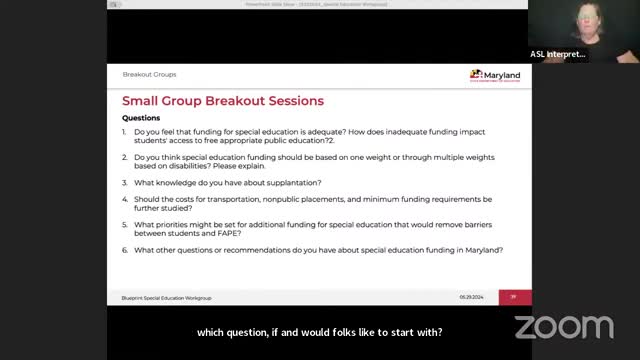Educators discuss funding disparities impacting special needs students in Maryland schools
May 29, 2024 | Maryland Department of Education, School Boards, Maryland

This article was created by AI summarizing key points discussed. AI makes mistakes, so for full details and context, please refer to the video of the full meeting. Please report any errors so we can fix them. Report an error »

On May 29, 2024, the Maryland Department of Education convened a workshop focused on the Blueprint for Special Education, where key discussions highlighted the disparities in funding and resources for students with disabilities across different counties. The meeting underscored the complexities of equitable funding in a system where local financial capabilities vary significantly.
One of the primary concerns raised was the inadequacy of a single-weight funding model, which does not account for the diverse needs of students with disabilities. Participants emphasized that while some counties, like Montgomery, have more resources, others, such as Washington County, struggle to meet the needs of their students. This discrepancy raises questions about fairness in educational opportunities, as schools with higher needs may not receive sufficient funding to provide necessary support, such as paraprofessionals or specialized services.
The discussion also touched on the implications of the Blueprint's requirement that 75% of funding be allocated at the school level. Some participants argued that this model fails to address the unique needs of students with disabilities, who often require more intensive support. They pointed out that the funding distribution does not reflect the reality of student needs, particularly in schools with smaller enrollments where a few students may have extraordinary requirements.
Donna, a participant, clarified that the 75% figure is intended as a minimum, not a maximum, suggesting that schools with higher needs should see increased funding. However, the conversation revealed a disconnect between the theoretical framework of funding and its practical application in schools, particularly in urban areas like Baltimore City, where budget constraints can limit the resources available for students with disabilities.
The meeting concluded with a recognition of the need for a more nuanced approach to funding that considers the specific requirements of students with disabilities. As discussions continue, stakeholders are urged to advocate for a system that ensures all students receive the support they need to thrive, regardless of their county's financial situation. The outcomes of these discussions will be crucial in shaping future policies and funding models aimed at improving educational equity across Maryland.
One of the primary concerns raised was the inadequacy of a single-weight funding model, which does not account for the diverse needs of students with disabilities. Participants emphasized that while some counties, like Montgomery, have more resources, others, such as Washington County, struggle to meet the needs of their students. This discrepancy raises questions about fairness in educational opportunities, as schools with higher needs may not receive sufficient funding to provide necessary support, such as paraprofessionals or specialized services.
The discussion also touched on the implications of the Blueprint's requirement that 75% of funding be allocated at the school level. Some participants argued that this model fails to address the unique needs of students with disabilities, who often require more intensive support. They pointed out that the funding distribution does not reflect the reality of student needs, particularly in schools with smaller enrollments where a few students may have extraordinary requirements.
Donna, a participant, clarified that the 75% figure is intended as a minimum, not a maximum, suggesting that schools with higher needs should see increased funding. However, the conversation revealed a disconnect between the theoretical framework of funding and its practical application in schools, particularly in urban areas like Baltimore City, where budget constraints can limit the resources available for students with disabilities.
The meeting concluded with a recognition of the need for a more nuanced approach to funding that considers the specific requirements of students with disabilities. As discussions continue, stakeholders are urged to advocate for a system that ensures all students receive the support they need to thrive, regardless of their county's financial situation. The outcomes of these discussions will be crucial in shaping future policies and funding models aimed at improving educational equity across Maryland.
View full meeting
This article is based on a recent meeting—watch the full video and explore the complete transcript for deeper insights into the discussion.
View full meeting
